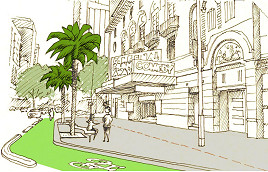Tram stops for bees?
City greening has become an influential idea in recent years. But what can it look like in Melbourne? How can we green our built-up CBD and its unique spaces?
A focus group set up by the Committee for Melbourne (CfM) is pushing for the greening of tram stop roofs to make new homes for bees.
Dr Clare McCausland is a member of the “MelBees” focus group – a project aiming to install green roofs on tram stops to assist the regeneration of the stingless honey-generating bee population in Melbourne.
“When we first got together to form the group, we had about 24 ideas floating around and one of my colleagues in the group pitched the idea of the green roofs – he said it would be a ‘bee superhighway’ along the city,” Dr McCausland said.
“Imagine the entire transport network with the greenery and the native plants to bring the bees back into the city and help restore that part of the ecosystem.”
“We knew it had been done successful- ly before and we really wanted to give it a Melbourne identity, which is why we’re looking at tram stops.”
Dr McCausland said the idea was based off a project that was successfully completed in the Netherlands.
The city of Utrecht in the Netherlands com- pleted wide-scale installation of green roofs on its bus stops last year. The initiative was taken to help cool the city and promote biodiversity, including bees and other insects.
Colony collapse disorder and varroa mite have affected bees in every continent except Australia. The havoc wreaked on bee populations, and by extension the ecosystem, has been severe.
But Dr McCausland said our cities still posed problems for bees, and Australian populations were vulnerable to the same threats as bees elsewhere through the overuse of pesticides, habitat loss and climate change.
“Australia has over 1600 species of bees and eleven species of stingless native bees,” Dr McCausland said.
“We know that the bees are dying, we know that populations are collapsing, and urbanisation plays a significant role in that. There’s a lot of concrete in any CBD and that’s just not appealing, so getting the plants in is a real priority,” she said.
“In addition to attracting the bees they have other benefits. For example, they help to filter the water – storm water that moves too quickly isn’t cleaned by vegetation.”
“And all greenery in the city reduces that heat island effect that we get in built-up areas.”
The MelBees project is in the process of final- ising designs and aims to wrap up in the middle of June. In May 2021, during which World Bee Day is scheduled, the project aims to launch a demonstration shelter.
“I think it would set us apart,” Dr McCausland said.
“It would really highlight to people outside of the city what a progressive, liberal, sustainable city we are. It would be a nicer city, trans- port shelters would be nicer to look at, people would have a stronger understanding of the value of insects to the ecosystem and of what the Melbourne ecosystem looks like.”

Council endorses office tower at Flinders Lane despite querying car park demolition




 Download the Latest Edition
Download the Latest Edition